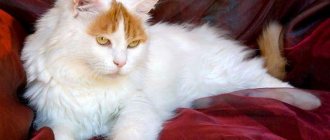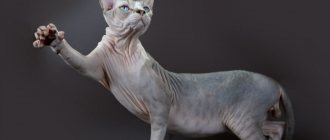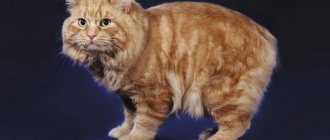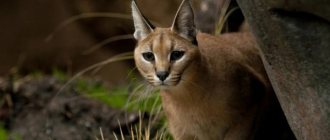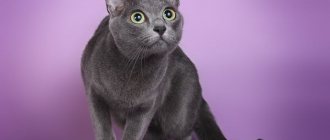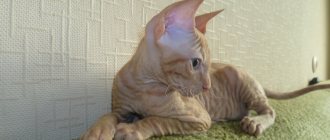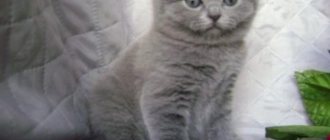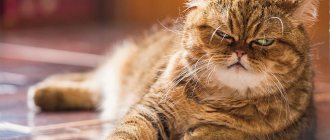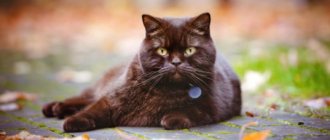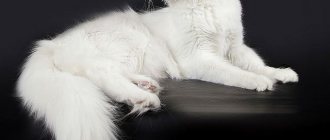Turkish van cat
- Fact 1:
In Turkish it is called Van Kedisi - “van kedisi” - Fact 2:
Belongs to a very ancient category of domestic cats - Fact 3:
Cats live up to 15 years - Fact 4:
This breed allocates one most important and only owner from all family members
The basis for the formation of the domestic cat breed under the name Turkish Van (the second option is the Van cat) was the aboriginal cat population that lived on the shores of the Turkish Lake Van. Research conducted by geneticists indicates that this spontaneously arose breed is one of the oldest.
There is a legend that the spot that many Vanir have on their shoulders was left from a divine touch. According to legend, the Van cat killed a mouse that intended to gnaw a hole in the bottom of Noah's Ark. For the salvation of animals and the human race, the Creator left a mark on her shoulder - the imprint of his finger.
Formation of the breed
Turkish Vans began to be imported to Europe about a thousand years ago (then they were called Van Katu or white ring-tailed cats), but the breed gained official status only in the 70s of the last century.
The formation of the Van cat breed is associated with the name of journalist Laura Lushington, who in the summer of 1955 collected material for publication in Turkey. Laura loved cats very much, so the charming local felines did not escape her attention.
An interested journalist was given a pair of different-sex kittens as a gift, and she took them with her to London. Along the way, the kittens managed to surprise their new owner with their unusual behavior: when it was decided to stop the car, which had overheated under the southern sun, the kittens jumped out of it and rushed into the stream, where they began to frolic. For people who were accustomed to cat hydrophobia and did not know that in their homeland Van cats swim well and catch fish in the water, this looked extremely unusual.
The kittens safely reached Great Britain, and 4 years later Laura again went to Turkey and returned from there with two more kittens, from which they managed to obtain offspring with repeating characteristics, which indicated the purebred breed line of these four-legged animals. This fact served as the basis for the further formation of the breed.
In 1971, Van cats received official recognition from the FIFe, and then they were gradually approved by other felinological societies.
Origin of the breed
There are several versions of the appearance of the Turkish Vans. The most popular legend dates back to the time of the Flood. According to it, after Noah took two white cats into the ark and landed on the shores near Mount Ararat, the animals descended to earth and became the progenitors of the entire cat family on earth. In the Van region, which belongs to modern Turkey, the remains of representatives of this breed were found, which lived here for many thousands of years. In addition to Turkey, these varieties live in Iraq, Syria, Iran, Armenia, and are actively spreading.
Turc de Van
It is believed that the proximity to Lake Van gave the animals the ability to swim. This is one of the highest lakes in the world, and the area is famous for its extreme temperatures. In order not to freeze in winter and easily cope with difficulties, the Turkish van has adapted over time. Light wool allows them to float well and withstand heat. The structure of their coat allows them to emerge from the water almost dry. In winter, the undercoat becomes thicker, and they easily get used to the cold. That is why, regardless of climatic conditions, anyone can become the owner of a Turkish van.
When archaeologists explored the region that gave the name to this breed, they found many artifacts depicting representatives of this family. Many finds date back to the 2nd millennium BC. Perhaps this is one of the most ancient breeds in the world.
It is interesting that if the Turks had not captured part of the territory of Armenia, where Lake Van is located, the cats would not have been called “Turkish”, but “Armenian”. In Armenia they are highly valued for their flexible nature.
If animals were brought to Europe by the crusaders, then they explored the Middle East together with traders. The modern history of such cats began in 1955, when British journalists went to Turkey to prepare a program about the country, meeting representatives of an unusual feline species there. One of the journalists was then given two red and white kittens. In 1959, the couple was joined by a cat named Anatolia (which is why the Turkish Van is also known as the Anatolian).
Cats arrived in the United States in 1970, but did not become popular until 1983. A couple of years later, the International Cat Association recognizes Turkish Vans as full-fledged representatives of the breed.
In 1992, the media reported that only 92 original Turkish Vans had been discovered in their homeland. As a result, the government developed a program to protect animals and preserve the species. Today, such cats are a national treasure, and their import is prohibited. This creates a number of difficulties in terms of breeding animals, since there are quite a few of them in the USA and Europe.
Breed characteristics
The Turkish Van is a large semi-longhaired cat breed. From the nose to the tip of the tail, its length varies between 90-120 cm. The height at the withers of adult cats reaches 40 cm, weight - 7-9 kg and they are fluffier than cats. And cats are much more graceful and smaller - 4-6 kg.
Vans have an elongated body, a massive neck, medium-sized paws, tufts of hair between the toes, and a wide and muscular chest. The head is medium in size and looks like a truncated triangle. The eyes are oval, blue or yellow, there are many individuals with different eyes (the iris of one eye is blue, and the other is yellow). The ears are wide at the base, with rounded tips.
The coat is silky, medium length on the body, and much longer on the tail. Almost or completely no undercoat (in this regard, the requirements of organizations vary). The body is always white, but the tail and spots on the body can be painted in other colors. The standards of the Van breed in the classifications of different felinological organizations have some differences, in particular, this concerns the colors and structure of the coat.
Recognized color options:
- Classic Van. Approved by all felinological organizations. The tail is red-chestnut, has 5-9 more intensely colored rings. The same color spots are located in the muzzle area and near the ears, sometimes in the area of the shoulders and back, the steel body is painted white;
- Tortoiseshell;
- Blue;
- Cream;
- Black.
Pure white cats are recognized by the TICA organization with the condition that they will be mated only with individuals of the traditional Van color.
Appearance of Turkish Van cats
Turkish Vans are fairly large cats with an athletic build. Cats are smaller than cats, and the latter can be 1.3 m long and weigh up to 9 kg (cats 6 kg). In addition, cats have thicker fur.
Head
The head of the Vanir has a smooth profile and wedge-shaped shape. The eyes are large, oval-shaped, blue, amber or copper in color, and heterochromia is also common. ears are large, high-set, with rounded tips.
Frame
The body of the Vanir is strong, elongated, narrowed towards the pelvis. The neck is muscular, the chest is rounded, the shoulders are broad. The tail is of medium length and pubescence.
Vans have strong legs , with the hind legs being slightly shorter than the front ones. The paws are round in shape, the pads are soft pink, and there is fluffy fur between the toes.
Coat and color
The wool of the Turkish Van has no undercoat, but has water-repellent properties similar to those of waterfowl feathers. This feature of the coat does not allow the cat to quickly get wet when swimming. The fur itself is of medium length, and in the summer it is shorter, and by winter the “collar” and “pants” grow.
The classic color of the Turkish Van is a chestnut-colored tail with brighter rings. There are red spots at the base of the ears and on the muzzle. The rest of the body has white fur. Recently, the following colors have been recognized among modern Vans:
- black and white;
- tortoiseshells;
- creamy white,
- white and blue;
- monochrome - black, white, cream, red and blue colors.
In their homeland, pure white Vans with heterochromic eyes are valued.
Health and physical development, buying a kitten
Turkish Vans have naturally good health, which they inherited from distant ancestors who survived under conditions of strict natural selection. The breed is characterized by slow maturation; the animal’s body reaches full development by 3-5 years. Average life expectancy is 15 years.
The Vanir have no genetic diseases. Among the ailments that are most common in cats of this breed, one can note allergies, so the diet for the cat must be carefully prepared, and for cleanliness in the house, choose hypoallergenic household chemicals. Pure white cats often have congenital deafness in one or both ears; this deviation is associated with the genetics of all white cats. That is why mating of two white individuals is prohibited.
Turkish Van kittens cost an average of 30-60 thousand rubles. There are only a few professional breeders and nurseries selling kittens in Russia. Taking cats out of Turkey is too problematic. Those who wish to purchase a purebred animal must carefully study all the kitten’s documents when purchasing and ask the seller to show the animal’s parents.
Documents that the breeder must provide
When purchasing a kitten, the breeder provides a veterinary passport, which contains all vaccinations, the pedigree of the kitten, and, if possible, its parents. This is especially true if you plan to participate in exhibitions in the future. When making a purchase abroad, a special veterinary certificate and an export permit are issued.
Due to the antiquity of the Van cat breed, there is a belief that knights participating in the Crusades brought them as gifts to their ladies.
Character, intelligence and habits
Turkish Vans are lively and cheerful cats, but somewhat capricious and prone to dominance. They try to take part in all family affairs, observing and often “helping” people in their daily activities.
If there are other cats and dogs in the house, they will treat them friendly, but they will definitely try to put themselves at the head of the “home pack” and dominate their four-legged brothers. These cats are also quite capable of finding a common language with large parrots, but they consider small rodents and aquarium fish only as potential prey.
Children are generally treated patiently, but do not like it when they force them to do anything or treat them rudely. Van cats do not tolerate oppression in any form whatsoever; they do not even allow themselves to be picked up, let alone squeezed. But at the same time, they really love attention and affection, they willingly climb onto their laps and demand to be petted.
Van breed cats are friendly towards all family members, but they single out one person as their owner, for whom they are imbued with special respect and love.
Their mind is unusually insightful. Many owners compare them with dogs in this regard, although the difference is still significant. For example, Vans understand learned voice commands very well, but they are in no hurry to carry them out if they are not in the mood for it. But a cat of this breed can clearly explain its desires and emotions to its owner using many shades of voice, persistence and very expressive facial reactions.
Compared to cats of other breeds, Vans sleep little. While awake, they often play noisy games with running and meowing, and really need participation from the owner. If the owner does not pay attention to the cat for too long and does not play with it, it begins to mope.
Many representatives of the Van breed love to swim, so they are not averse to joining the owner in a bath. At the same time, you need to remember that too hot water is contraindicated for cats, and especially for them you can fill the bath with moderately warm water.
Character
Representatives of the breed are friendly, devoted to people, intelligent, love to be cuddled, but are reluctant to be held. Reviews from owners show that they are easy to train. They are easily accustomed to the tray and leash. They get along well with children, but do not allow themselves to be treated too freely.
Powerful, well-developed leg muscles allow cats to be jumping, so it is not surprising to see a pet on a closet, wall shelf or curtain under the curtain rod. This fact must be taken into account and the pet must be provided with a ball, toys and active games.
Genetic features: the ability to swim, lack of undercoat and waterproof wool, which arose under the influence of wild nature.
Maintenance and care
The wool of Vans is not prone to tangling, has dirt- and moisture-repellent properties, brushing it 1-2 times a week is quite enough, during periods of heavy shedding - 2-3 times a week. Shedding in cats of this breed is seasonal, occurring in spring and autumn.
Although Vans love water, they should not be washed frequently. An exception is if the cat is very dirty, an exhibition is approaching, or the owner is allergic to cat fur: in this case, the cat can be washed once every 6 weeks, this will avoid provoking allergic attacks in the owner.
If a cat's claws grow excessively, they need to be carefully trimmed with a nail clipper. It is enough to wipe the eyes and ears once a week, clean the teeth with a soft brush and toothpaste for animals 1-2 times a week.
Van cats love walks, so it is useful to regularly walk them on a harness with a leash. If it is not possible to go outside with your pet, you need to set up a place for him on the balcony or windowsill, where he could look out the window.
The smarter the animal, the more entertainment it needs. When it comes to the Turkish Van, there is no such thing as too much play. You need to pamper him with new toys regularly, you can also hide old ones for a while. Cats of this breed love interactive cat toys that use logic.
In addition to this, it is advisable to purchase or make your own play set for your pet with scratching posts and an open-type bed located at a considerable height, since cats of this breed love to watch what is happening from above.
Vans get used to the litter box quickly. Any type of toilet is suitable for them, but keeping in mind the ease of allergies, it is better to choose filler for their litter box without fragrances.
Appearance description
The color appearance varies from red-chestnut to white. But it is believed that the snow-white pattern of a purebred animal should not occupy more than 80% of the surface. Tortoiseshell, blue, black, and cream colors are also popular. Currently, white cats of this breed are recognized by TICA and other associations, although with minor reservations. They are considered mestizos and crosses with Angora varieties. Currently, most associations recognize peach, blue, black and tri-colors in addition to the traditional coat color.
In winter, the cat's fur becomes thicker throughout the body, with the exception of the head. Its structure is similar to cashmere and does not retain water.
Vanir food
Turkish Vans are unpretentious in food, however, economy and premium food, as well as food with a high copper content (they provoke unwanted shades in the coat) are absolutely not suitable for them. When introducing new ingredients into the diet, you need to carefully monitor the cat's condition. If signs of allergy appear, the product should be immediately excluded.
The diet can be made up of high-quality natural food or complete ready-made super premium food. Among ready-made dry food, you need to choose high-calorie food, with a full range of essential nutrients and vitamins that will satisfy the body needs of mobile and active Van cats.
Suitable natural foods include rabbit, turkey, lamb and beef. It is better to avoid chicken, as its meat often causes allergies. Twice a week you can give offal (less liver, so that the coat does not acquire an undesirable shade). A small amount of boiled rice can be mixed with meat and offal. It is better not to experiment with other grains, since rice is the only grain to which cats are not allergic.
Once a week you can dilute the diet with boiled sea fish, 2-3 times a week give fermented milk products without sugar and other additives. From time to time it is useful to feed your cat raw and stewed vegetables, as well as young green grass - sprouted oats or wheat.
Features of color
The main difference between the breed is the colored spots on a white background. Patterns and shades vary. Sprinkles of white are acceptable at the tip of the tail. The most popular pattern is tabby stripes.
Followers of Islam believe that Allah himself left these marks on the cat, blessing it to fight rodents that were supposed to destroy Noah's ark. Markings are most often cream, red, blue, and black. The paw pads and nose of this breed are usually pink.
Owner reviews
“This is the first time I’ve seen a cat who loves to swim so much! Our Leopard loves water treatments. This is probably because before these were wild cats, they caught their own fish and became accustomed to water. And Leopard is also very beautiful, fluffy and snow-white. He is very affectionate, always sleeps in his head on the pillow and never conflicts with our dog. Although he was not noticed to have any special love for her.” Konstantin, Simferopol.
***
“Our Lizonka is almost 10 years old. Turkish Van, that’s the name of her breed, we took her on purpose. Or rather, they were looking for a cat with a suitable character, and the choice fell on this breed. Lizok is calm, although capricious. It is not fussy about food; it can eat both dry food and regular food. Her weakness is fish, she even tries to fish in an aquarium. She is also fascinated by the sight of water flowing from the tap. He can watch the stream for hours and try to play with it. He loves children, a lot and with pleasure, allows himself to be cuddled, but does not give offense.” Elena, Kursk.
***
My Assol was found in the trash. She was looking for food, she was terribly dirty, with deep cuts, apparently, she had fought with other stray cats. I felt sorry for her, I just fed her, and she followed me. Then I washed her, treated her, vaccinated her. Now I will not give up this affectionate miracle for any money. I had never heard of the Turkish Van breed before, but now I know that they are the best cats in the world. She is neat, understands the word “impossible” very well, loves people, is very grateful and unpretentious.” Svetlana, Smolensk.
Personality of Turkish Van cats
The Vans are distinguished by their independence and single-mindedness - they become attached to one person and consider him their master. These cats have a playful nature and are not averse to playing even in old age.
Hunter
As in the legend, the Vanir are good hunters - it’s not for nothing that God blessed them for a good hunt! If a cat lives in a country house, you can be sure that she will definitely go hunting and will boast to you about the prey she has brought. Turkish Vans love active outdoor games, so it is better to stock up on various toys that will appeal to them.
Student
The Turkish Van is a very trainable cat. He will happily do everything his owner asks and even learn to fetch a toy.
Friend
As already mentioned, the Turkish Van is a monogamous person and becomes attached to one person. He will not show that he is bored without his person, but when the owner comes, he will be very happy. He is devoted to his owner like a dog, truly loves him and is sincerely grateful.
He is patient with a leash or harness and will happily go for walks outside. Van also loves to sit on the shoulders of his owner - this way he feels at the top, can survey his possessions and consider himself in charge. However, you shouldn’t blame him for this.
The Van cat is a big fan of “talking”, both out loud and in sign language, which he also masters perfectly. So communication with him promises to be full and varied, from purring to meowing in different ways, depending on the cat’s mood and the situation.
In addition, the Turkish Van gets along well with other pets living with him in the house, and even with dogs. However, these cats are very capricious, do not tolerate a subordinate position and will always seek the special favor of the owner. They prefer to dominate over other pets.
Nanny
Van will also get along great with children, mainly due to his activity and love of running around and playing. Vans alone are not known for being calm and imposing, but when paired with a child they can have a lot of fun! By the way, Van could use a climbing frame where he can spend his energy.
However, they do not willingly allow themselves to be stroked or caressed unless they want it, and if they are too persistent, they can even show their claws. Therefore, children need to be more restrained and not squeeze their pet, and small, unintelligent children should not be left alone with these cats for a long time.
Van cat cost
Acquiring a representative of this breed is not an easy task. There are very few breeders in Russia and neighboring countries, and the cost of cats is quite high. Here it is important to carefully study the reviews and pedigree. The seller is obliged to provide a passport of the kitten’s parents, documents certifying that the animal belongs to the breed.
The average cost of a small kitten in Russia starts from 10,000-20,000 rubles and is much higher depending on the pedigree. The cost will include the cost of preparing the pet for shipment and issuing certificates, since most often it is brought from abroad.
Even in Turkey, Vans should only be purchased from official breeders; their price in their historical homeland starts from a thousand dollars. It’s better to go look at the kittens with a specialist. But you can also explore the issue yourself and take into account the following details:
- Almost equal rings of two colors should run along the kitten’s tail;
- the presence of small spots on the back is acceptable;
- There are purebred kittens from individuals belonging to the same breed, and breeds with admixtures, which may cost less.
It is extremely rare, but still, a van can be accidentally found on the street if it was thrown out by some unscrupulous owner. You can also look at advertisements for cat shelters, which often house lost animals. Many also give away their pets due to moving or for other reasons (allergy to wool, birth of a child). Therefore, there is always a chance to become the owner of a handsome thoroughbred at minimal cost.
Content Features
The Turkish Van is strongly attached to home and family and is not very trusting of strangers, so owners of private houses fearlessly take him in. He will feel comfortable in an apartment, but in this case it is recommended that the kitten be taught to walk on a leash and be walked regularly in the future. The van must have a corner for relaxation and at least 2-3 toys in free access.
A Turkish Van does not have to regularly fill the bath with water and put live fish in it, like a civet cat, but he certainly won’t refuse such fun. There is no need to take full baths, just enough water to cover the paws. Many Vans enjoy playing with a thin stream from the tap, and sometimes even become interested in the water in the toilet, which for obvious reasons should not be encouraged. Due to the absence of undercoat, the wool dries quickly.
Turkish Van is not hypoallergenic. But it has no undercoat, and the guard hair and skin are not prone to dust accumulation and are covered with a minimal amount of natural oils, so the breed can be adopted with caution by people who are allergic to cat fluff. Undesirable for those whose reactions are provoked by saliva, other particles or secretions. Care
Turkish baths are low maintenance. The shedding is weak, and with regular brushing it is almost unnoticeable. The hair is straight, soft, so it is easy to comb and does not tangle. In general, these cats are quite clean and take care of their personal hygiene on their own. Occasionally, owners should look into the ears to make sure they are clean or wipe the corners of the eyes. Claws are trimmed as needed.
Frequently bathing a cat with shampoo is not recommended. There is a need to use only a special product for soft wool. While taking water procedures, it is advised to play with the cat; most likely, she will really like it.
Feeding
The diet of Turkish Vans should be balanced. Basically no different from feeding other cats of similar breeds. Most owners prefer to give their cats dry food. These must be complete premium or super-premium diets. There should always be water in the bowl, which should be changed at least once a day.
